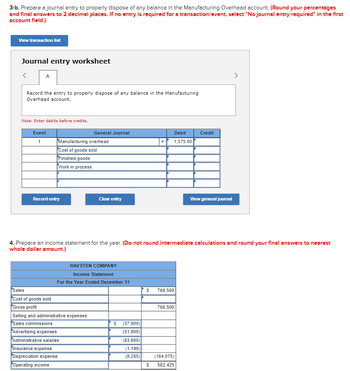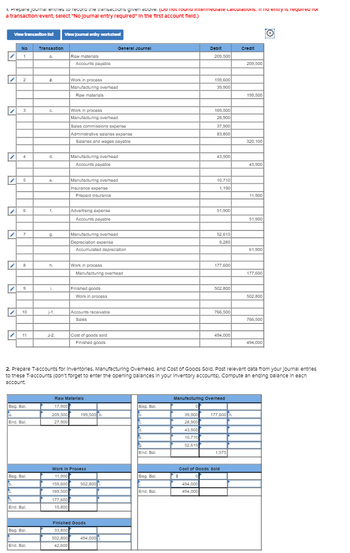Ravsten Company uses a job-order costing system. On January 1, the beginning of the current year, the company's Inventory balances were as follows: Raw materials Work in process Finished goods The company applies overhead cost to jobs on the basis of machine-hours. For the current year, the company estimated that it would work 36,000 machine-hours and incur $159,840 in manufacturing overhead cost. The following transactions were recorded for the year: $17,900 $ 11,900 $33,800 a. Raw materials were purchased on account: $209,500. b. Raw materials were requisitioned for use in production: $199,500 (80% direct and 20% Indirect). c. The following costs were incurred for employee services: Direct labour Indirect labour Sales commissions Administrative salaries $169,500 $ 28,900 $ 37,900 $ 83,800 d. Heat, power, and water costs were incurred in the factory: $43,900. e. Prepaid insurance expired during the year: $11,900 (90% relates to factory operations, and 10% relates to selling and administrative activities). f. Advertising costs were incurred, $51,900. g. Depreciation was recorded for the year: $61,900 (85% relates to factory operations, and 15% relates to selling and administrative activities). h. Manufacturing overhead cost was applied to production. The company recorded 40,000 machine-hours for the year. 1. Goods that cost $502,800 to manufacture according to their job cost sheets were transferred to the finished goods warehouse. J. Sales for the year totalled $766,500 and were all on account. The total cost to manufacture these goods according to their job cost sheets was $494,000.
Process Costing
Process costing is a sort of operation costing which is employed to determine the value of a product at each process or stage of producing process, applicable where goods produced from a series of continuous operations or procedure.
Job Costing
Job costing is adhesive costs of each and every job involved in the production processes. It is an accounting measure. It is a method which determines the cost of specific jobs, which are performed according to the consumer’s specifications. Job costing is possible only in businesses where the production is done as per the customer’s requirement. For example, some customers order to manufacture furniture as per their needs.
ABC Costing
Cost Accounting is a form of managerial accounting that helps the company in assessing the total variable cost so as to compute the cost of production. Cost accounting is generally used by the management so as to ensure better decision-making. In comparison to financial accounting, cost accounting has to follow a set standard ad can be used flexibly by the management as per their needs. The types of Cost Accounting include – Lean Accounting, Standard Costing, Marginal Costing and Activity Based Costing.
Required:
1. Prepare journal entries to record the transactions given above. (Do not round intermediate calculations. If no entry is required for a transaction/event, select "No
2. Prepare T-accounts for inventories, Manufacturing Overhead, and Cost of Goods Sold. Post relevant data from your journal entries to these T-accounts (don’t forget to enter the opening balances in your inventory accounts). Compute an ending balance in each account.
3. Prepare a journal entry to properly dispose of any balance in the Manufacturing Overhead account. (Round your percentages and final answers to 2 decimal places. If no entry is required for a transaction/event, select "No journal entry required" in the first account field.)
4. Prepare an income statement for the year. (Do not round intermediate calculations and round your final answers to nearest whole dollar amount.)

Step by step
Solved in 3 steps

Part of 3b and 4 need to be answered still properly










